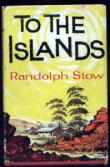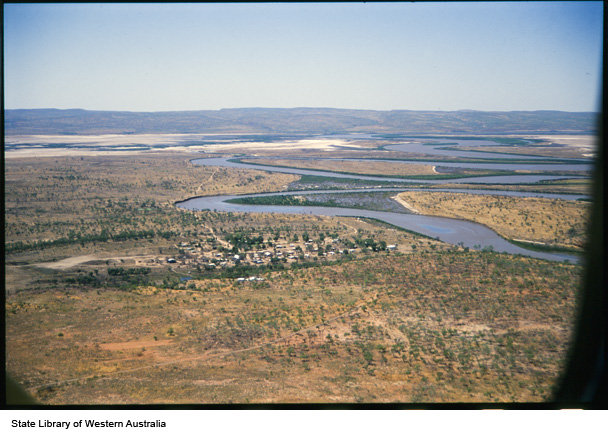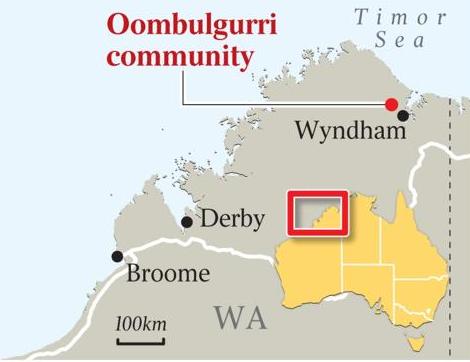AustLit
-
This trail collects a range of items to enhance readers' engagement with To the Islands.
– Part One provides an overview of To the Islands, its author Randolph Stow, and some background to the novel's genesis and setting.
– Part Two highlights the role of William Shakespeare's King Lear as a model for Stow's protagonist in To the Islands.
– Part Three focuses on the novel's themes of alienation, journey and home, and of expiation and reconciliation.
– Part Four places Stow's novel within the context of developments in Australian literature during the 1950s.
– Part Five offers suggestions for wider reading.
– Part Six provides tips for further research.
Click on the hyperlinks below to visit AustLit records and external references. Some of the critical works and other resources are available online.
-
 This image has been sourced from online.See full AustLit entry
This image has been sourced from online.See full AustLit entry'To the Islands concerns the ordeal of Stephen Heriot, an elderly, careworn, and disillusioned Anglican missionary who abandons his mission when he mistakenly believes he has accidentally killed one of his Aboriginal charges in a not entirely unprovoked confrontation. Heriot flees into the desert not to escape justice but to embrace its desolate beauty and its elemental purity as the one objective reality and the one certainty left available to him.
Heriot's flight and his embrace of the desert may be seen as his attempt, as a European Australian, to immerse himself in the landscape, to make himself one with the land.
(...more) -
See full AustLit entry
Randolph Stow is the son of Cedric Ernest Stow, a country lawyer, and Mary Stow nee Sewell. Both sides of the family were fifth generation Australians at the time of Stow's birth. The Stows came from Hadleigh in Suffolk, England. The Reverend Thomas Quinton Stow (1801-1862) arrived in South Australia in 1837 and helped settle Adelaide. A number of distinguished lawyers and judges are descendants. The Sewells from Essex in England arrived in 1836 and were pastoralists in the Geraldton district of Western Australia.
-
Randolph Stow's To the Islands (1958) followed the publication of his first novel A Haunted Land (1956), and a collection of poetry, Act One: Poems, and a second novel, The Bystander (both in 1957). Each of these four books was published by MacDonald, a London publishing house that continued to publish Stow's works until the mid-1960s.
To the Islands won the second Miles Franklin Literary Award (1958) and the 1959 Australian Literature Society Gold Medal. (The first Miles Franklin recipient was Patrick White for Voss. A number of scholars have drawn comparisons between White's and Stow's two novels. See below for further detail.) AustLit lists nearly 30 published reviews of To the Islands in the period 1958-1959. In the fifty or so years that followed, over fifty critical articles have focused on Stow's third novel.
-
In 1981, Angus and Robertson released a revised edition of To the Islands. In his preface to the revised version, Stow notes that the novel, completed shortly after his 22nd birthday, 'contains many faults, due partly to immaturity, but more to the fact that my technical competence was not equal to my ambition'. He goes on to say: 'In the original edition I was consciously making propaganda on behalf of Christian mission-stations for Aborigines, in particular for one Mission on which I had worked for a short time'.
The mission referred to is the Forrest River Anglican Mission near Wyndham in Western Australia's Kimberley region which operated from 1913 to 1968. Stow worked there as a ration-storeman in 1957. Changes in government policy during the 1960s and 1970s meant that most passages relating to the difficulties of operating a mission were no longer relevant and were therefore omitted from the revised version.
For further reading on the revised edition, see Sue Thomas's 'Randolph Stow's Revision of To the Islands' (1982).
-
Forrest River Mission and Other Settings
As Fiona Richards affirms in her 2012 article 'The Islands of Randolph Stow' Stow's experiences at the Forrest River Mission 'translated directly into' the writing of To the Islands' and much of the novel 'draws on Stow’s observations of Forrest River’ (104, 105-106).
Further information on the operation of the Forrest Mission (also known as Oombulgurri and as Umbulgara) is available in Noel Loos' White Christ Black Cross: The Emergence of a Black Church. Aboriginal Studies Press, 2007. See particularly chapter four, 'The Golden Age of Missions: 1900–1950’ (accessible online on the Little Red Yellow Black website). The Find & Connect web resource, which 'brings together historical resources relating to institutional "care" in Australia', also has background information on the Forrest River Mission. Click here to view this site.
The image (above right) is a 1993 aerial photograph of Forrest River Mission, sourced from the State Library of Western Australia.
For information on other settings in the novel, including maps and photographs, see the entry for To the Islands in The Cultural Atlas of Australia.
-
Oombulgurri - Location of the Forrest River Mission at which Randolph Stow worked in 1957
-
Speaking to Candida Baker in 1986, Randolph Stow said: 'The old man [Heriot] in To the Islands is there really because I was thinking of King Lear, and that play’s pre-occupation with death' (289). (Yacker 3: Australian Writers Talk About Their Work (1989): 289).
Comparisons with Lear are raised in several articles about To the Islands. Michael Cotter writes that Heriot is dispossessed in a way that 'somewhat resembles the progress of Lear, that archetype of dispossessed kings' and that he is 'granted the painful luxury of solitude in order to recognise his own share in human suffering: as perpetrator and concomitantly as victim' ('The Image of the Aboriginal in Three Modern Australian Novels.' Meanjin 36.4 (1977): 587).
Anthony J. Hassall in Strange Country: A Study of Randolph Stow (1986) also traces Lear threads in Heriot's situation. Heriot is unable to step out of his role as missionary 'but the role has become oppressive, and he longs for release from it ... Heriot is trapped: he cannot bear to stay, and yet he cannot leave' (34).
In his preface to the revised edition, Stow confessed: 'Nowadays I should hardly dare tackle such a King Lear-like theme; but I do not regret having raised the large questions asked here, and so wisely left unanswered’ (2002 UQP rev. ed.: xiii).
-
Heriot is searching ‘for a pure “ground” that is socially, spiritually, and ideologically neutral and unmarked by [his] colonizing community, a space where [he] may evade psychological torments’ (45). (Lovesey, Oliver. 'The Place of the Journey in Randolph Stow's "To the Islands" and Sheila Watson's "The Double Hook."' Ariel 27.3 (1996): 45
-
Stephen Heriot, Stow's missionary protagonist in To the Islands, is alienated from both the mission's northern Australian landscape and the Indigenous community among whom he lives – ‘He saw himself for the first time as a stranger, cast without preparation into the landscape of prehistory, foreign to the earth. Only the brown man belonged in this wild and towering world' (2002 UQP ed., 100).
Bill Ashcroft, in 'The Horizon of the Future' (2014) explores the idea that, as in many of Stow’s novels, 'there is a strong feeling of displacement but displacement that provides the motivation for becoming (27).
Anthony J. Hassall, who has written major commentaries on Stow's novels, notes that Stow is ‘a private rather than a social observer, he confronts us, in achingly beautiful writing, with men who are alone, adrift in the outback, the desert or the jungle, searching for peace within themselves and with God. Like their search for love, their search for personal reconciliation is seldom rewarded, but always intensely and empathetically imagined’. Heriot's inner alienation in To the Islands is 'the alienation of the Europeans in a landscape they have claimed but not yet truly possessed ... Heriot is a richly human character engaged in an agonised search for a home in an alien universe'. ('Vanishing Wunderkind.' Australian Book Review 314 (September 2009): 31, 29).
-
Heriot sets out in search of the Indigenous community's islands of the dead. As Bruce King puts it, he is on 'a quest toward spiritual renewal and redemption ... His physical sufferings are part of a spiritual journey, a pilgrimage, through life toward death and judgment, like Everyman in the medieval morality play, as well as an attempt to accept the Aboriginal world’ ('Randolph Stow's Novels of Exile' Antipodes. 1.2 (November1987): 76)
This quest has led scholars to draw parallels with the journeys in Patrick White’s Voss, published in 1957, the year before Stow's novel. As Anthony J. Hassall puts it in his monograph Strange Country: A Study of Randolph Stow (1986): ‘The time to begin the exploration of the unprofessed religious factor in Australian life had clearly arrived, and a journey through the inner and outer landscape seemed to be the way towards the truth ... Believing that a key to the Australian soul lay in the Australian landscape, they [Stow and White] took their protagonists away from the European huddle on the fringes of the continent to seek its meaning, and their own, in the empty desolation and silence of the interior’ (28).
Kathleen M. Steele examines the gendering effects of the 'literary wanderer' in Voss and To the Islands in the first part of her PhD thesis '"Splendid Failures": The Wanderer in Patrick White's Voss (1957) and Randolph Stow's To the Islands (1958) ; and, The September Sisters' (2014).
-
At journey's end, Heriot says tells his companion, 'I have come home now ... This is home' (UQP rev. ed. (2002): 175).
In her 2014 article 'Heriot's Ithaka: Soul, Country and the Possibility of Home in To the Islands, Bernadette Brennan observes that, 'like David Malouf's Ovid (nearly two decades later [in An Imaginary Life]), Heriot has to abandon knowledge, language and self-pity in order to overcome his separation from the landscape. Like Malouf’s Ovid, Heriot eventually reaches a place or a state of mind that is before and beyond language and intellectual knowledge: a state of heightened intuitive perception and openness to experience’ (3-4).
-
Expiation and Reconciliation
Towards the close of To the Islands, Heriot remarks that 'in all my – expiations, there’s never been a reconciliation' (2002 UQP rev. ed.: 161). Both Anthony J. Hassall (in Strange Country: A Study of Randolph Stow (1986) and Leonie Kramer (in 'The Novels of Randolph Stow.' Southerly 24.2 (1964): 78-91) comment on Heriot's Christ-like desire to take upon himself the sins of those who committed the Onmalmeri massacre (the fictionalised name for the Oombulgurri massacre). Hassall says this desire is 'egotism disguised as idealism' (45); Kramer notes that Heriot fails to achieve the reconciliation he seeks (87).
During the first decade of the 21st century, Australia's major political parties wrestled with opposing views regarding the desirability of an apology to the country's 'Stolen Generations' of Indigenous people. John Howard (Prime Minister from 1996 to 2007) represented the view that 21st century Australians could not meaningfully apologise for the actions of earlier generations; Kevin Rudd (Prime Minister from 2007 to 2010 and again, briefly, in 2013) believed an apology was appropriate and necessary. The denouement of these views is enunciated in Rudd's ‘Apology to Australia's Indigenous Peoples’ on 13 February 2008 and Howard's statement to Harvard University's John F. Kennedy School of Government on 11 March 2008.
http://www.youtube.com/embed/b3TZOGpG6cM -
In his chapter on To the Islands in Strange Country: A Study of Randolph Stow (1986) Anthony J. Hassall writes that 'Voss and To the Islands ‘signalled a crucial move in Australian fiction away from social realism towards the more experimental and internalized fiction of major twentieth-century novelists like Faulkner, Woolf and Joyce’ (28). Stow himself began his introductory note to the 1958 edition by stating: 'This is not, by intention, a realistic novel'. Expanding on that statement in his preface to the revised edition, Stow wrote that this declaration ('which has been widely misrepresented as a sort of manifesto') expressed his 'irritation with the tyranny, in Australia, of social realism. In the 1950s novelists, one gathered, were supposed to concern themselves with Statistically Average Man, and he did not interest me' (2002 UQP rev. ed.: ix).
In 1961, Vincent Buckley, then a senior lecturer at the University of Melbourne, delivered the annual Commonwealth Literary Fund lecture. In the lecture, Buckley reflects on a new stage in the development of Australian literature, opened up – he says – by Patrick White. In this new ‘stimulus to our literature’, White opens up the ‘range of Australian fiction ... by conceiving and acting out the dramas of his characters in an imaginative world with one more dimension than our novelists have generally recognised as existing ... It is mythopoeic, metaphysical, even religious’ (144). It is Buckley's argument that Randolph Stow and Christopher Koch were among the young novelists who responded to White’s 'door-opening' (145). ('In the Shadow of Patrick White.' Meanjin Quarterly 20.2 (July 1961: 144-154).
-
- The missionary figure Heriot offers a number of quotes from European literature in the course of To the Islands. Sources for these quotations include Charles Baudelaire’s Les Fleurs du Mal, John Marston’s ‘The Malcontent’, and Samuel Taylor Coleridge’s ‘The Rime of the Ancient Mariner’. See 'Bernadette Brennan's 'Heriot's Ithaka: Soul, Country and the Possibility of Home in To the Islands' (2014), John Beston's 'Heriot's Literary Allusions in Randolph Stow's To the Islands' (1975) and Jennifer Wightman's 'Waste Places, Dry Souls: The Novels of Randolph Stow' (1969) for further discussion.
- Randolph Stow references two exploratory journeys that he consulted in the writing of To the Islands: those of C. Price Conigrave and of his great great uncle Jefferson Stow. A digitised version of the account of one of Conigrave's journeys in the Kimberley, 'North Australian Trails' (published in the New Nation Magazine in September 1932), is available via the State Library of Victoria's website.
- To the Islands includes an account of a massacre of Aboriginal people. The fictionalised account is based on the 1926 Oombulgurri Massacre. Randolph Stow, in the only footnote in To the Islands, states that he took down a verbatim account of the massacre during his stay at the Forrest River Mission in 1957. This account of the original massacre was provided by Daniel Evans. See Klaus Neumann's 'The Stench of the Past: Revisionism in Pacific Islands and Australian History' (1998) and Bruce Elder's Blood on the Wattle: Massacres and Maltreatment of Australian Aborigines Since 1788 for further analysis.
- The common perceptions of Indigenous Australians held by the broader Australian community during the 1940s and 1950s were often echoed in the poetry and prose of the period. However, some writers, including Randolph Stow, Patrick White and Judith Wright looked more deeply into Indigenous culture and reflected their understandings in their writing. Adam Shoemaker discusses the approaches adopted by this latter group of authors in his chapter 'The Literary Perception, 1945-1961' in Black Words, White Page: Aboriginal Literature 1929-1988(1989). (This chapter is available via the ANU EPress website.)
- Robyn Wallace, in 'Messiahs and Millennia in Randolph Stow's Novels' views To the Islands as an Ars Moriendi vessel, ‘suffused as it is with images of, allusions to, and statements about dying' (58). ‘Ars Moriendi’ (the ‘Art of Dying’) refers both to specific Christian texts, dating from the 15th century, and to the art of dying well. See the online Encyclopedia of Death and Dying for further general background.
-
- There is additional information in AustLit about Randolph Stow and To the Islands – follow the links within Stow's author record and the record for To the Islands to explore more.
- To further investigate subjects such as the ‘quest motif’, go to the AustLit search page and explore the Advanced Search options. For help on building searches, visit the 'How to Search AustLit' page.
- To discover more about the ultimate demise of the Oombulgurri township in 2011, see news items published in late 2014: 'Former Residents Oppose Plans to Demolish Buildings at Remote Oombulgurri Community' (Australian Broadcasting Commission website) and 'The Trauma of Oombulgurri's Demolition Will Be Repeated across Western Australia' (Guardian newspaper website).
- Elements of Taoist philosophy are present in Randolph Stow's early novels, including To the Islands, and are more strongly evident in his 1963 novel Tourmaline. Articles explaining the basic tenets of this traditional Chinese philosophy can be discovered by searching for the term 'Taoism' via an internet browser.
You might be interested in...






